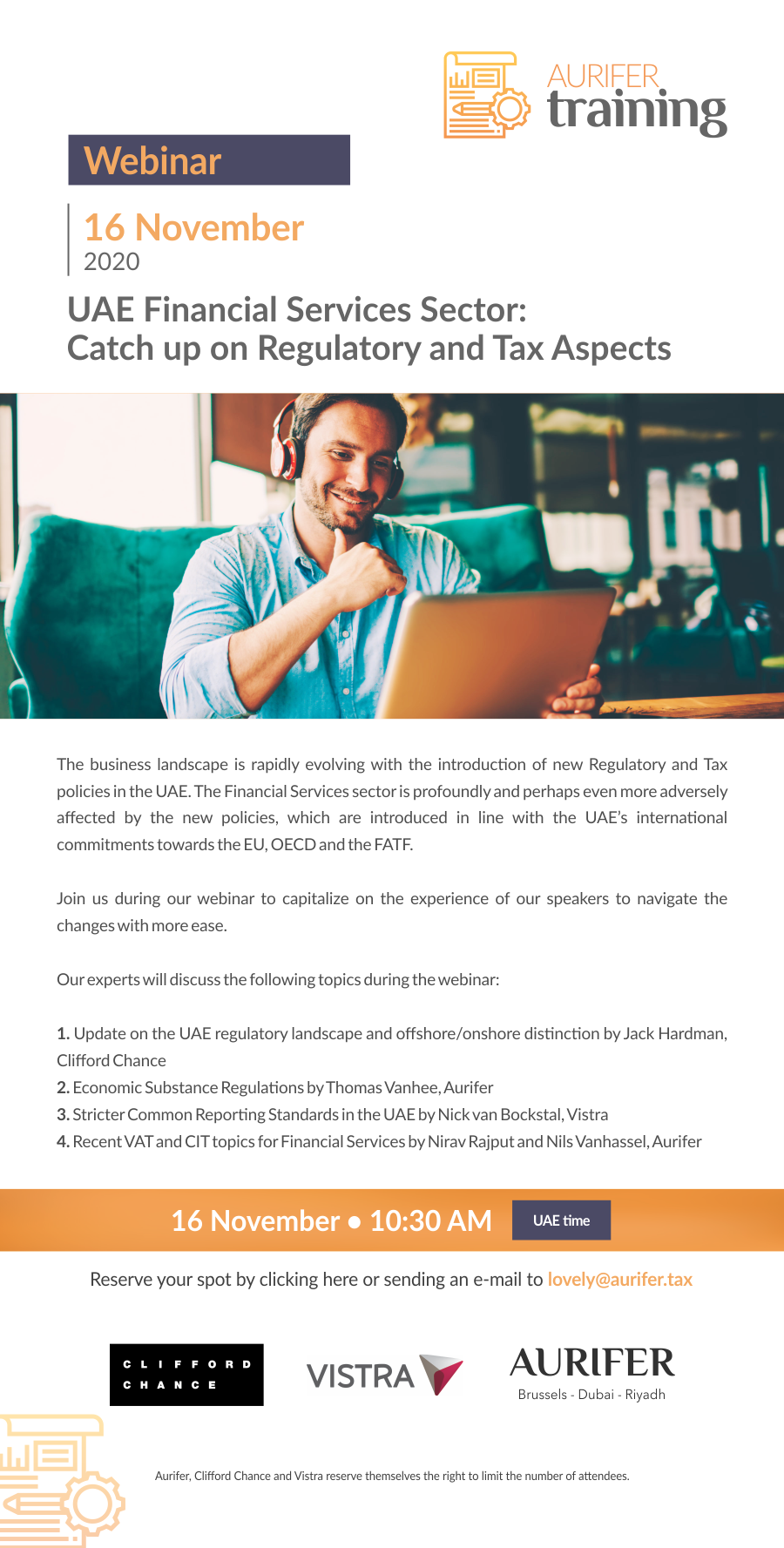1. Introduction
The United Arab Emirates (UAE) is a tax friendly country, imposing no personal income tax and no federal corporate income tax. Nevertheless, it has recently introduced a set of new tax driven disclosure requirements which have significantly increased the level of transparency for individuals and multinational groups with operations in the country.
This development mostly originates from the work delivered by the Organization for Economic Co-operation and Development (OECD) and G20 during the past few years on measures against Base Erosion and Profit Shifting (BEPS), more specifically Action 5 of the BEPS Action Plan introducing certain minimum standards that countries should implement to counter harmful tax practices and Action 13 introducing Country-by-Country Reporting (CbCR) to increase global tax transparency. The Financial Action Task Force (FATF) on the other hand has been the key driver behind the recent Ultimate Beneficial Owner disclosure rules.
This analysis will cover the main three components of the new UAE measures, namely:
1. CbCR – governed by Cabinet Resolution No 44 of 2020
2. Economic Substance Regulations (ESR) – governed by Cabinet Resolution No 57 of 2020 and Ministerial Decision No 100 of 2020
3. Ultimate Beneficial Owner (UBO) declaration – governed by Cabinet Decision No 58 of 2020
We will not be analysing Common Reporting Standards (CRS) and the Foreign Account Tax Compliance Act (FATCA), which are also disclosure regimes but which have been in place for longer.
This article comes at a time where the deadlines for compliance with these new disclosure requirements are fast approaching (i.e. filing of CbCR and ESR reports and resubmission of Notifications before 31 December 2020), while other compliance dates have already passed, such as for the submission of UBO data before or on 27 October 2020 and the initial submission of CbCR and ESR Notifications before 31 December 2019 and 30 June 2020 respectively.
Keeping this in mind, this publication aims to 1. provide the reader with an understanding of the new compliance requirements, 2. highlight the impact for individuals and multinational groups 3. illustrate some common pitfalls for those preparing and submitting CbCR, ESR and UBO reports and 4. explain why consistency in the information is of the essence.
2. New disclosure arrangements
2.1 CbCr
2.1.1. Context
In the Framework of the Base Erosion and Profit Shifting (BEPS) project of the OECD and the G20, countries agreed, amongst others, to implement BEPS action 13 in order to tackle the shortcomings of the international tax system.
This action prescribes that countries implement legislation requiring multinational enterprises (MNEs) to report annually and for each tax jurisdiction in which they do business certain relevant financial and qualitative information, which is subsequently exchanged with other countries. The data should allow tax administration and governments to assess MNEs’ Transfer Pricing risks and it could also provide a first indication whether MNEs are involved in BEPS behaviours.
2.1.2. Scope
The UAE’s legislation very much mirrors the common and internationally accepted standard imposed by the OECD which has by now been adopted by almost 100 countries globally. The CbCR disclosure requirement is applicable to UAE headquartered groups with operations in at least two different tax jurisdictions. The rules are only applicable if the consolidated revenues during the Financial Year preceding the Financial Year in scope is equal to or exceeds AED 3.15 billion.
Ultimate Parent Entities (UPEs) in the UAE of large MNEs will therefore have the obligation to file a CbCR to the Ministry of Finance (“MoF”). As of yet, the Federal Tax Authority is not involved in the CbCR process, even though it would also be competent according to its Establishment Law. There is no (longer a) requirement for notifications for UAE constituent entities for MNEs of which the UPE is located outside the UAE.
Whilst there is also a requirement for Transfer Pricing Master Files and Local File documentation as part of the OECD’s BEPS Action 13, the UAE has currently not introduced such a requirement. We do not expect the UAE to implement a requirement to file a Master File or Local File as long as it does not have Federal Corporate Income Tax. Furthermore, there is no requirement to file a Controlled Transactions Disclosure Form or similar document (KSA on the other hand has recently implemented such requirement). Since there is no requirement for CbCR filing by foreign headquartered MNEs in the UAE, there is also no need to monitor the implementation of exchange of information relations between countries .
2.1.3. Disclosures
In Table 1 of the CbCR , MNEs need to list financial information grouped on a country per country level regarding revenues (third-party and intercompany), profits (losses) before income tax, income tax paid, income tax accrued, stated capital, accumulated earnings, number of employees, and non-cash or cash-equivalent net tangible assets.
In addition to the above information, Table 2 of the CbCR asks for information about activities for each company of the MNE (e.g. Research & Development, Holding Intellectual Property, Procurement, Manufacturing, Sales, Marketing, Distribution, Administrative support services, third-party services, intercompany financing, financial services, insurance, holding, dormant or others). Additionally, the tax residency, address and Tax Identifications Numbers for each of the subsidiaries needs to be disclosed. Table 3 provides a free field for MNEs to provide additional information (such as source of data, reporting periods, foreign exchange rate used, strategic positions taken, etc.).
The CbCR needs to be filed by the end of 2020 for companies with a financial year matching Gregorian calendar years. The portal can be found here: https://www.mof.gov.ae/en/StrategicPartnerships/Pages/Country-by-Country-Reporting.aspx.
2.1.4. Impact
The importance of the first time submission to the Ministry of Finance of the CbCR for large multinational groups headquartered in the UAE cannot be underestimated.
This is because companies operating in the UAE so far had no strict requirement to disclose financial information about their own operations and/or that of affiliated companies to any regulatory authority in the country (except for publicly listed companies). For most of the privately owned large multinational businesses headquartered in the UAE, the CbCR requirement results in the first-time disclosure of such global scale (and sometimes considered sensitive) information to a regulatory body.
With the CbCR data, the Ministry of Finance (and foreign governments) will gain valuable insights, not only about the financial position of the aforementioned privately owned large multinational groups, but will also receive data about publicly listed companies which may not have been available in the public domain previously (e.g. headcount, taxes paid rather than tax provisions, functional profile of affiliates, etc.).
In line with the OECD’s intention, the Ministry of Finance has stated on its website (FAQ section) that the CbCR data will be used for 1. assessment of high-level transfer pricing risk, 2. assessment of other BEPS-related risks and 3. for economic and statistical analysis. This being said, it is yet to be observed how the Ministry (and potentially other governmental bodies) will analyze and/or use this wealth of information for decision-making. For example, neighboring countries with income tax regimes such as the Kingdom of Saudi Arabia and Oman may be interested in such information.
2.1.5. Common pitfalls
Although the CbCR may look seemingly straightforward to fill out, there is a range of errors which can be made. The OECD already listed a number of them[1]. The below section is listing (in a non-exhaustive manner) a few important considerations which we formulate and which should be kept in mind by those preparing and/or submitting a CbCR:
i. Sourcing of information
At the outset, one should be able to determine if a multinational group headquartered in the UAE exceeds the AED 3.15 billion global revenue threshold for filing of a CbCR. While we discuss below what exactly constitutes a multinational group and what should (not) be included under revenues in this calculation, many may face time-consuming and burdensome challenges in the data collection process. Importantly, revenues are an indicator of size, and size is an indicator of complexity.
Even though the CbCR Table 1 groups the financial information on a country-by-country level, the underlying workings usually require the information to be sourced for each legal entity separately. In this respect, some enterprises may have a single and all-encompassing source of information available to them that covers all companies in the group (e.g. consolidation and/or enterprise resourcing system), others will typically operate in an environment where information about the parent company and affiliates (such as stand-alone financial accounts, headcount data, functional profile, taxes paid, tax numbers for all legal entities, etc.) is available across different platforms and/or is managed by various teams at a global scale.
In such cases, it is important for those preparing a CbCR to consistently follow either a “top-down approach” (starting from consolidated information that is centrally available and filling in gaps by sourcing of information from other platforms and various teams) or a “bottom-up” approach (aggregation of data from all decentralized sources). In addition, a reconciliation of both approaches may be advised.
In all cases, it would be appropriate to standardize and document the approach that is consistently followed in a company specific process document and make mention of this approach in Table 3 of the CbCR.
ii. Defining a “Group of companies”
In line with the OECD standards, a Group is defined in the Cabinet Resolution as “A group of companies related through ownership or control, such that it either is required to prepare Consolidated Financial Statements for the purposes of preparing financial reports under the applicable accounting principles, or would be so required if the equity interests in any of the companies were traded on a public securities exchange”. This definition is primarily dependent on applicable accountings standards, such as the International Financial Reporting Standards (IFRS) for example.
Furthermore, in order to fall under the scope of the UAE CbCR requirements, a group of companies should be headquartered in the UAE, have operations in two or more countries (and exceed the AED 3.15 billion threshold as mentioned earlier). The UAE has limited the CbCR disclosure to UAE headquartered groups, whereas the previously repealed legislation also required Surrogate Parent Entities (“SPE”) for foreign headquartered MNEs to file the CbC report.
At first glance, the definition of “group of companies” may appear straight-forward. However, there are certain important considerations that should be kept in mind for CbCR purposes, such as:
· The CbCR preparation requires information to be collected at a legal entity / permanent establishment level (which may not always align with an enterprise-specific IT and/or corporate coding structure)
· There may be differences between the legal structure and accounting consolidation. For example, are there any legal entities that are in- or excluded from the accounting consolidation that should have been ex- or included if the group were publicly listed under IFRS 10 rules?
· Whilst legal entities may be legally owned by (a part in) the group, there could exist special arrangements following which “control” is with other parts of the group or even an outside party or vice versa (e.g. side agreements)
· For Joint Venture arrangements, the OECD has clarified earlier that an entity that is not required to be consolidated under applicable accounting rules (e.g. equity accounted companies), does not have to be considered for the CbCR.
As a final note on this subject, it is worth mentioning that the OECD mentioned in the public CbCR consultation paper of February 2020 that it is looking at a possible revision to the definition of a “group of companies” so that in the future one CbCR may need to be filed for different groups / accounting consolidations that are under common control (by an individual for example).
iii. Definition of “revenues”
For CbCR purposes, revenues are the “top-line” in the income statement which includes all trading income, gains, or other inflows shown in the financial statement prepared in accordance with the applicable accounting rules. This definition also includes extraordinary income and gains from investment activities (e.g. extraordinary or below the line income from services, royalties, interest on loans, premiums, net gain on sale of property, etc.).
A common pitfall is to include dividend income from subsidiaries for the calculation of the AED 3.15 billion threshold and/or for the reporting of revenues and profits before taxes in Table 1 of the CbCR. On the other hand, dividend income from associates, joint ventures, and investment securities should be included in revenues and profits before taxes.
Reversals (of provisions and impairments), foreign exchange conversion differences and other non-business income type of items should be excluded from revenues.
When amounts are reported on a net basis in the financial statements under applicable accounting rules (e.g. net interest income for financial institutions) this should be reported as net in the CbCR as well.
iv. Foreign exchange rate
Most UAE based large multinational groups that will have to file a CbCR will do so in the AED currency. Because the report contains financial information from companies abroad using a non-AED currency for financial reporting, it is important to consider what foreign exchange rate needs to be used for translation of such non-AED currency amounts into AED.
A common mistake made by preparers of the CbCR is to rely solely on the FX rate conversion system that is embedded in the consolidation or accounting software , which would typically use year-end exchange rate for balance sheet amounts and transaction dated exchange rate for P&L amounts. The guidance provided by the OECD clearly states however that for the CbCR preparation, foreign currency amounts should be translated to the single CbCR functional reporting currency using the internal average foreign exchange conversion rates for the financial year concerned for both balance sheet and PL amounts (see OECD Transfer Pricing Guidelines, version 2017, page 513).
v. Definition of tangible assets
This Column in Table 1 of the CbCR requires reporting of the sum of the net book values of tangible assets (accounting definition), including inventory, properties, plants, equipment, investment properties and development properties.
A common mistake made in the CbCR data reporting is that cash or cash equivalents, intangible assets and/ or financial assets are included.
vi. XML conversion
Filing of the CbCR on the MoF portal is required in XML format in accordance with the OECD reporting schema. The UAE requires the filing to be made in Schema version 2.0, which may be challenging because the OECD only expects countries to adopt the Schema 2.0 standard as from February 2021 (most countries have adopted the 1.0 Schema thus far). Many software providers are not yet ready to offer the Schema 2.0 solution and the guidance notes released by the OECD for XML conversions to be done by MNEs are limited.
Most preparers of the CbCR will use standard functionalities of Excel to collect and aggregate the data. The process of conversion of this Excel data into XML format can be complicated and time-consuming for those unfamiliar with XML technology. Therefore, companies should start thinking about creating this capability in-house or using external service providers, some of which have developed easy to use applications for CbCR XML generation.
2.2. ESR
2.2.1. Context
On 30 April 2019, the UAE issued Cabinet Decision No. 31 concerning economic substance requirements (Economic Substance Regulations or “ESR” in short). It later replaced this Cabinet Decision with Cabinet Decision No. 57 of 2020, which had different Implementing Regulations.
UAE onshore and free zone entities that carry on specific activities mentioned in the regulations need to examine whether they meet the economic substance requirements. Failing to meet those will trigger penalties.
The introduction of a legal framework regulating the economic substance criterion in the UAE is a direct consequence of the OECD’s ongoing efforts to combat harmful tax practices under Action 5 of the BEPS project.
It also follows the increased focus by the European Union (EU) Code of Conduct Group (COCG) on companies established in jurisdictions with a low or no income tax regime, resulting in the publication of the first EU list of non-cooperative jurisdictions. In response to the EU COCG initiatives, the governments of Anguilla, the Bahamas, Bahrain, Barbados, Bermuda, British Virgin Islands (BVI), Cayman Islands, Guernsey, Isle of Man, Jersey, Turks and Caicos islands all recently introduced economic substance rules. The UAE followed suit as well.
There has also been growing interest and scrutiny from the public opinion as to whether entities established in no or low tax jurisdictions should be required to have sufficient economic substance before being able to benefit from beneficial tax regimes and benefits under double taxation agreements.
The purpose of ESR is to curb international tax planning of certain business activities, which are typically characterised by the fact that they are “mobile” in nature because they do not require extensive fixed infrastructure in terms of human and technical capital, in a way which allows the business (and attached profits) to be shifted to no or nominal tax jurisdictions, as opposed to taxing profits where the company has actually created economic value.
One of the many reasons why the UAE has attracted so many businesses is because there is currently no income tax regime at a federal level. The ESR legislation therefore is specifically targeted at businesses that do not have genuine commercial operations and management in the UAE to support the underlying activities and therefore also the underlying income.
Economic substance requirements are used to analyze whether a company’s presence in a country such as the UAE has a commercial and/or business purpose rather than reduction of a tax liability.
2.2.2. Scope
The Economic Substance Regulations apply to UAE onshore and free zone entities that carry out one or more of the following activities:
· Banking
· Insurance
· Fund management
· Lease-finance (including intercompany lending for interest income)
· Headquarters
· Shipping
· Holding company
· Intellectual property (IP)
· Distribution and service centre
Especially the definition of distribution and service centre catches a great deal of businesses. Service centre is defined as “providing services to foreign related persons”. Given the fact that the UAE is a regional hub focused on Foreign Direct Investment, a very important part of UAE incorporated businesses falls into this scope.
Entities are required to meet the Economic Substance Test when they conduct any of the above activities and earn income from such activities.
For each Activity, the regulations have defined the so-called Core Income Generating Activities (“CIGA”). This is a list of activities that must be conducted in order to meet the Economic Substance Test. For example, for intellectual property the CIGA would consist of research and development.
In general, the Economic Substance requirements will be met:
· If CIGA are conducted in the UAE;
· If the activities are directed and managed in the UAE;
· If there is an adequate level of qualified full-time employees in the UAE,
· If there is an adequate amount of operating expenditure in the UAE,
· If there are adequate physical assets in the UAE.
In case the CIGA are carried out by another entity, these need to be controlled and monitored.
In accordance with EU recommendations, the regulations provide for less stringent requirements for Holding Company Businesses (“Holding Companies”). Then again, for IP Companies, the standards are set higher.
2.2.3. Disclosures
Businesses that conducted a Relevant Activity during the 2019 Financial Year were required to file an ESR notification by end of June 2020 to the respective licensing authorities, such as the Ministry of Economy for onshore companies and free zone regulators for offshore companies.
Whilst the Ministry of Economy did not require companies to submit an ESR Notification if no Relevant Activity was conducted in the Financial Year 2019, some free zone authorities required a Notification for all companies irrespective of the nature of their activities (e.g. DIFC).
2020 was a transitional year with a revised ESR legislation retroactively impacting businesses and a change in the structure in terms of the enforcement (i.e. the Federal Tax Authority now has the mandate to review ESR filings, issue penalties where appropriate and handle litigation matters).
As a consequence of the revised legislation, businesses now need to resubmit their ESR notifications if Relevant Activities have been performed in FY 2019 and file their economic substance report if income was earned from the Relevant Activities by the end of December 2020 to the Ministry of Finance.
The revised ESR legislation introduced 5 categories of exemptions, amongst which the UAE branch of a foreign head office is the most common exception. However, for this particular exception to apply, it requires that the UAE branch’s income is subject to tax abroad in the country of the head office (to be demonstrated by a copy of the foreign income tax return). The exemptions generally entail important administrative requirements. Benefiting from the exemptions means that no Economic Substance Report needs to be filed (but the Notification is still required).
If a business conducts a relevant activity and has relevant income, and cannot benefit from an exemption, it needs to demonstrate substance in the UAE. The UAE has chosen for a substance over form method and not a “one size fits all” approach, where the conducted activity is important and there is no minimum threshold for meeting the substance.
The requested information as part of the ESR Notification and ESR Report is listed in the official templates published by the MoF, along with a link to the portal for submissions: https://www.mof.gov.ae/en/StrategicPartnerships/Pages/ESR.aspx
2.2.4. Impact
Similar to the effect of CbCR, the UAE companies that are in scope of the new ESR reporting requirements at the year-end will need to disclose, possibly for the first-time ever, sensitive financial and other information (revenues, profits, operating expenditures, headcount, etc.) to a regulatory body in the UAE.
Specifically, the requirement to inform the Ministry of Finance whether the financial accounts of the company (or its consolidating parent company) are being audited and the need to upload financial statements (it is assumed that also non-audited financial statements will be accepted) can trigger the attention of companies’ Tax, Finance and Legal teams. This is because so far compliance with the requirement for UAE companies to prepare and/or submit financial statements to a UAE regulatory body has been spotty.
Finance teams of UAE companies that have not been preparing financial statements and that are in scope of the new ESR regulations will need to prepare a set of financial accounts in a format that is presentable to the Ministry of Finance (expected to cover at a minimum a balance sheet, income statement, cash flow statement and notes).
Similarly, some companies may need to prepare and keep available, for the first time ever, formal Board resolutions (or single manager decisions) which can be requested by the Ministry of Finance and/or the Federal Tax Authority at any time. For companies without a formal Board of Directors, which are for example operating under the leadership of a single Director or Manager, this may pose the question if sufficient evidence for the “directed and managed” test can be provided to the MoF.
2.2.5. Common pitfalls
A thorough and well-documented process for the examination of the substance (not only the form) of activities for each UAE license is absolutely necessary. For this process, the scope of “Relevant Activities” needs to be well understood, because although some definitions may appear straightforward at first glance (e.g. Lease-Finance), the reality of their application may be wider than initially thought (e.g. Lease-Finance includes intercompany lending for interest income while trade credit arrangements are not in scope).
The examination of Relevant Activities should be made on per license basis. For example, while a legal entity with multiple licenses in the UAE (e.g. one onshore and two different licenses in two separate free zones) is generally involved in routine trading operations and therefore would initially be considered outside the scope of the ESR rules, it may be required to file an ESR Notification and/or Report if a significant Relevant Activity is conducted under one of the licenses (e.g. one of the free zones branches is regulated by the Insurance Authority and underwrites insurance for the products sold).
The UAE MoF has clarified that “Relevant Income” means all of an entity’s gross income from a Relevant Activity as recorded in its books and records under applicable accounting standards. A literal interpretation of this clarification would mean that abstraction needs to be made of any actual cash flows for the income in scope. For example, a holding company that records a dividend income in its FY 2019 financial statements, but that is not actually receiving the dividend cash proceeds, would still be required to submit an ESR Notification and Report.
A common reason why businesses might not meet the substance test is that Board Meetings are not physically held in the UAE. In addition, the meeting minutes need to be signed by all members. It may surprise that this condition is necessary in a globalized world, where board members can be dialing in from other countries. These antiquated methods may conflict with modern decision making. In addition, where UAE businesses are looked after by a local manager, he may have a certain degree of autonomy but perhaps not full autonomy. What meets the substance level then?
In a country where free zones often act as landlords as well, it may surprise that the UAE has not prescribed a minimum level of space for offices per license, as this would have created a higher demand for commercial real estate (we do note however that the square footage needs to be provided as part of the ESR report). Additionally, the ESR sometimes conflict with commercial considerations for free zones (e.g. attracting IP for solely licensing purposes would not meet the DEMPE criterion under the ESR).
2.3. UBO
2.3.1. Context and scope
By way of Cabinet Decision No. 58 of 2020, the UAE has implemented a new UBO regime applicable to businesses established in the UAE, except for ADGM and DIFC businesses which already have their own UBO requirements in place. Government owned businesses are excluded from the UBO regulations.
Under the new UBO regime, businesses in the UAE are subject to stricter disclosure obligations. Some Free Zone companies, such as the ones established in the DIFC, already were subject to UBO requirements and therefore the new regime does not change much for them.
The new UBO regime is derived from the Financial Action Task Force (FATF)’s Guidance on Transparency and Beneficial Ownership and it stems from the Anti Money Laundering legislation in the UAE, more in particular Federal Decree-Law No. 20/2018 and its Implementing Regulation. It is suspected to target amongst others disclosures of nominee structures.
The new UBO regime requires businesses in the UAE to maintain beneficial ownership and shareholder registers at their registered office, and to submit information from these registers to their regulatory authority (e.g. Department of Economic development, DED in short or a Free Zone Authority). Any changes in the information previously provided need to be disclosed as well.
2.3.2. Disclosures
The requirement to submit the UBO Register was earlier based on ad hoc requests from the licensing authorities, for example whenever requesting for issuance of a new trade license for a new legal entity in the UAE. However, with the latest Decision, UAE entities are required to maintain a UBO Register more consistently and update the Regulators accordingly for any changes.
A beneficial owner can be determined as follows:
1. Any physical person who owns or ultimately controls through direct or indirect ownership shares at the rate of 25% or more, or whoever has the right to vote at the rate of 25% or more, including retaining ownership or control through other means such as the right of appointment or dismissal of most of the Managers.
2. If no physical person was determined as per (1), the physical person who exercises control over the legal person through other means such as the right of appointment or dismissal of most of the Managers
3. If no physical person can be determined as per (1) or (2), then the physical person who holds the position of the person in charge of Senior Management.
The UBO Register needs to contain the following information on the UBO:
· Name, nationality, date and place of birth
· Place of residence or address
· Number of travel document/ID card, country, date of issuance and expiry
· Basis on which the UBO is the UBO
· Date of acquiring capacity as UBO
· Date on which UBO ceased to be UBO
In this section, we are not discussing the Shareholder or Partner Register.
2.3.3. Impact
In addition to similarities with ESR regulations which also require the disclosure of the UBOs as part of some of the Notifications and Reports, the Foreign Account Tax Compliance Act (FATCA) and Common Reporting Standards (CRS) already required UAE businesses to provide a certain level of information regarding the UBOs. From a tax perspective, it should be ensured that the information provided to the financial institutions and relevant Regulatory Authorities (MoF and licensing authorities) is consistent and under no circumstances incorrect. Inconsistent or misleading information may lead to significant penalties being imposed by the Authorities.
3. Conclusion – Managing and matching disclosures is a delicate exercise
In recent years, the UAE has been signing up to different international standards and conventions to request from companies certain information and exchange this with other countries. From a tax perspective, the UAE did already have broad exchange of information provisions in its large network of double tax treaties.
With the introduction of FATCA/CRS and CbCR, the UAE signed up to different Multilateral Competent Authority Agreements (MCAA in short) for the automatic exchange of information with other countries.
A few years back, the UAE MoF put different MoU’s in place with different authorities, such as e.g. the DIFC, DMCC, RAKFTZ and others. The intention was to allow these authorities to act as agents to collect information from their members, which the MoF required in its international relations.
The recently introduced set of regulations around CbCR, ESR and UBO add another layer to the obligations of UAE businesses.
Whilst the new UAE disclosure requirements detailed above are governed by three separate Cabinet Resolutions, it is important to keep in mind that the information that needs to be provided under the separate regulations is centralized in the hands of the Ministry of Finance (CbCR and ESR), the Federal Tax Authority (ESR) and Licensing authorities (UBO). These bodies can compare and check the consistency of the information being provided for a specific UAE company.
For example, the Ministry of Finance would be able to check if a UAE company that was reported under a certain classification in Table 2 of the CbCR (e.g. Holding, Headquarter, Dormant, IP company, etc.) matches with the information (not) submitted as part of the ESR declarations.
Another example is that where the identity of the UBOs declared to the Licensing authorities as part of the new UBO requirements should match with the UBO information included in ESR filings.
With the implementation of the different regulations, the UAE has lifted itself onto the level of global transparency for tax matters. Although some businesses are still waking up to the impact, insufficiently realizing the consequences of setting up shell companies and other companies, the wake-up call should really be answered now. For other international businesses, it simply entails that they have additional compliance obligations in the UAE, like they would have in other countries. The level of “red tape” is still relatively doable from a tax perspective, given that there is no federal corporate income tax. The UAE keeps its position as an attractive tax jurisdiction given that it additionally applies no withholding taxes and no capital gains tax.















